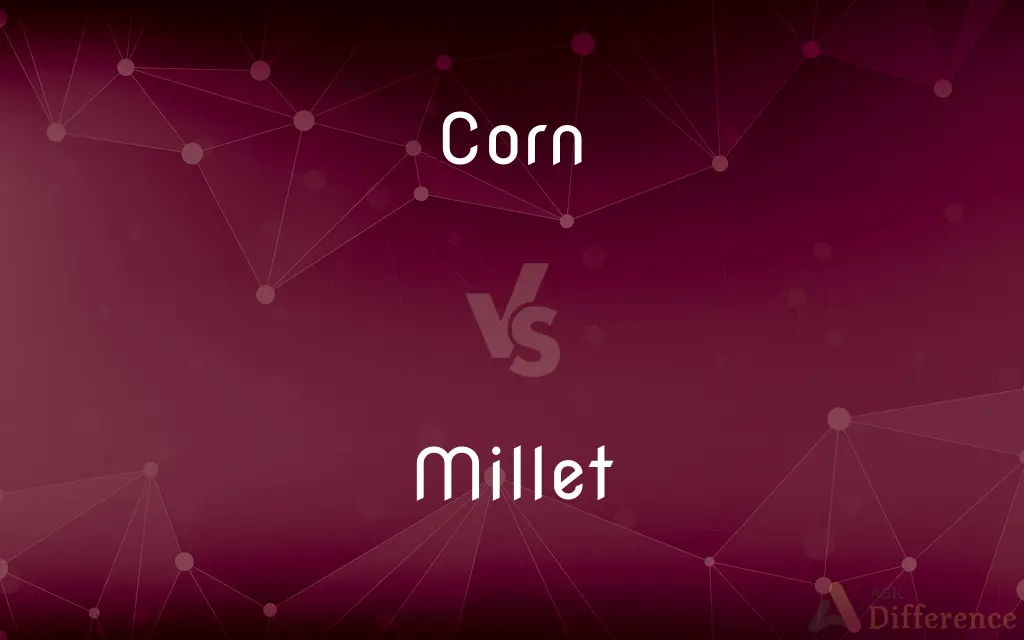Corn vs. Millet — What's the Difference?
Edited by Tayyaba Rehman — By Fiza Rafique — Updated on November 6, 2023
Corn is a large grain plant domesticated by indigenous peoples in southern Mexico, while millet is a group of small-seeded grasses widely grown as cereal crops or grains for fodder and human food.

Difference Between Corn and Millet
Table of Contents
ADVERTISEMENT
Key Differences
Corn, known scientifically as Zea mays, is a cereal grain with a large cob from which kernels are harvested. Millet refers to small-seeded grasses that are harvested as grains in various species, such as pearl millet, foxtail millet, and proso millet.
Corn is a staple food in many parts of the world and is used in a variety of products, including cornmeal, corn syrup, and corn oil. Millet, on the other hand, is often used in bird seed and as a traditional grain in some developing countries, although it is gaining popularity as a health food.
One key difference between corn and millet is that corn is grown as a mono-cropped annual, requiring a significant amount of water and fertilizer. Millet is more drought-tolerant, can be grown in harsh environments, and is commonly used in crop rotation systems due to its ability to improve soil health.
Corn is typically yellow but can come in a variety of other colors, such as white, red, and blue. Millet grains are generally small and can be white, gray, yellow, or red. The nutritional content also differs, with corn being high in carbohydrates and millet being high in fiber and protein.
While corn is often genetically modified to increase yield and resistance to pests, millet is largely non-GMO, which makes it appealing to those looking for organic or traditional food options. Both grains can be popped like popcorn, but popped millet is much smaller in size compared to corn.
ADVERTISEMENT
Comparison Chart
Botanical Family
Poaceae (specifically Zea)
Poaceae (various genera)
Kernel Size
Large
Small
Water Requirement
High
Low (drought-tolerant)
Nutritional Content
High in carbohydrates
High in protein and fiber
Typical Uses
Food products, animal feed, ethanol
Health foods, bird seed, traditional cuisines
Cultivation
Often mono-cropped and genetically modified
Usually non-GMO and used in crop rotation
Popularity
Staple food worldwide, especially in the Americas
More common in Africa and Asia; gaining global popularity
Compare with Definitions
Corn
Corn is a cereal plant that yields large kernels on a cob.
He harvested the corn from his field in the late summer.
Millet
Millet is a group of small-seeded grains widely grown around the world.
Millet has been an important food staple in Africa for centuries.
Corn
Corn is used as a major feed grain for livestock.
The farmer bought two tons of corn to feed his cattle.
Millet
Millet is praised for its high nutritional value and gluten-free properties.
She switched to millet flour to bake gluten-free bread.
Corn
Corn can be processed into a variety of products including biofuel.
The corn harvest this year will be used to produce ethanol.
Millet
Millet is adaptable to growing in harsh climates and poor soils.
Millet thrives in the arid conditions where other grains fail.
Corn
A cone-shaped and often painful inwardly directed callus of dead skin that forms at a pressure point near a bone, or on a weight-bearing part of the body.
Millet
Millet is often included in the diet for its beneficial health effects.
His doctor recommended adding millet to his diet for better digestion.
Corn
The chief cereal crop of a district, especially (in England) wheat or (in Scotland) oats
Fields of corn
Millet
Millets () are a group of highly variable small-seeded grasses, widely grown around the world as cereal crops or grains for fodder and human food. Millets are important crops in the semiarid tropics of Asia and Africa (especially in India, Mali, Nigeria, and Niger), with 97% of millet production in developing countries.
Corn
Something banal or sentimental
The film is pure corn
Millet
A cereal grown in warm countries and regions with poor soils, bearing a large crop of small seeds which are chiefly used to make flour.
Corn
A small, painful area of thickened skin on the foot, especially on the toes, caused by pressure.
Millet
Any of various annual grasses with small grains that are harvested for food, livestock feed, and birdseed, especially proso millet.
Corn
Any of numerous cultivated forms of a widely grown, usually tall annual cereal grass (Zea mays) bearing grains or kernels on large ears.
Millet
The grains of any of these plants.
Corn
The grains or kernels of this plant, used as food for humans and livestock or for the extraction of an edible oil or starch. Also called Indian corn, maize.
Millet
A demographic group in the Ottoman Empire, defined in terms of religious affiliation and enjoying a degree of legal autonomy.
Corn
An ear of this plant.
Millet
Any of a group of various types of grass or its grains used as food, widely cultivated in the developing world.
Corn
Chiefly British Any of various cereal plants or grains, especially the principal crop cultivated in a particular region, such as wheat in England or oats in Scotland.
Millet
(specifically) common millet, in particular Panicum miliaceum.
Corn
A single grain of a cereal plant.
Millet
(historical) A semi-autonomous confessional community under the Ottoman Empire, especially a non-Muslim one.
Corn
A seed or fruit of various other plants, such as a peppercorn.
Millet
The name of several cereal and forage grasses which bear an abundance of small roundish grains. The common millets of Germany and Southern Europe are Panicum miliaceum, and Setaria Italica.
Corn
Corn snow.
Millet
Any of various small-grained annual cereal and forage grasses of the genera Panicum, Echinochloa, Setaria, Sorghum, and Eleusine
Corn
(Informal) Corn whiskey.
Millet
French painter of rural scenes (1814-1875)
Corn
(Slang) Something considered trite, dated, melodramatic, or unduly sentimental.
Millet
Small seed of any of various annual cereal grasses especially Setaria italica
Corn
A horny thickening of the skin, usually on or near a toe, resulting from pressure or friction. Also called clavus.
Millet
Millet can be used as both human food and bird seed.
I filled the bird feeder with millet for the sparrows.
Corn
To cause to form hard particles; granulate.
Corn
To season and preserve with granulated salt.
Corn
To preserve (beef, for example) in brine.
Corn
To feed (animals) with corn or grain.
Corn
To form hard particles; become grainy
"After the snow melts all day, it corns up at night for fine conditions" (Hatfield MA Valley Advocate).
Corn
Any cereal plant (or its grain) that is the main crop or staple of a country or region.
Corn
Maize, a grain crop of the species Zea mays.
Corn
A grain or seed, especially of a cereal crop.
He paid her the nominal fee of two corns of barley.
Corn
A small, hard particle.
Corn
(uncountable) A type of granular snow formed by repeated melting and refreezing, often in mountain spring conditions.
Corn
Bullets, ammunition, charge and discharge of firearms
Corn
Money.
Corn
A type of callus, usually on the feet or hands.
Corn
(countable) inflammatory disease of horse hoof, at the caudal part of the sole.
Corn
(countable) skin hyperplasia with underlying fibroma between both digits of cattle.
Corn
Something (e.g. acting, humour, music, or writing) which is deemed old-fashioned or intended to induce emotion.
Corn
To granulate; to form a substance into grains
To corn gunpowder
Corn
To preserve using coarse salt, e.g. corned beef
Corn
To provide with corn (typically maize; or, in Scotland, oats) for feed
Corn the horses.
Corn
To render intoxicated
Ale strong enough to corn one
Corn
To shoot up with bullets as by a shotgun (corn).
Corn
A thickening of the epidermis at some point, esp. on the toes, by friction or pressure. It is usually painful and troublesome.
Welcome, gentlemen! Ladies that have their toesUnplagued with corns, will have a bout with you.
Corn
A single seed of certain plants, as wheat, rye, barley, and maize; a grain.
Corn
The various farinaceous grains of the cereal grasses used for food, as wheat, rye, barley, maize, oats.
Corn
A tall cereal plant (Zea mays) bearing its seeds as large kernels in multiple rows on the surface of a hard cylindrical ear, the core of which (the cob) is not edible; - also called Indian corn and, in technical literature, maize. There are several kinds; as, yellow corn, which grows chiefly in the Northern States, and is yellow when ripe; white corn or southern corn, which grows to a great height, and has long white kernels; sweet corn, comprising a number of sweet and tender varieties, grown chiefly at the North, some of which have kernels that wrinkle when ripe and dry; pop corn, any small variety, used for popping. Corn seeds may be cooked while on the ear and eaten directly, or may be stripped from the ear and cooked subsequently. The term Indian corn is often used to refer to a primitive type of corn having kernels of varied color borne on the same cob; it is used for decoration, especially in the fall.
Corn
The plants which produce corn, when growing in the field; the stalks and ears, or the stalks, ears, and seeds, after reaping and before thrashing.
In one night, ere glimpse of morn,His shadowy flail had thrashed the corn.
Corn
A small, hard particle; a grain.
Corn
To preserve and season with salt in grains; to sprinkle with salt; to cure by salting; now, specifically, to salt slightly in brine or otherwise; as, to corn beef; to corn a tongue.
Corn
To form into small grains; to granulate; as, to corn gunpowder.
Corn
To feed with corn or (in Sctland) oats; as, to corn horses.
Corn
To render intoxicated; as, ale strong enough to corn one.
Corn
Tall annual cereal grass bearing kernels on large ears: widely cultivated in America in many varieties; the principal cereal in Mexico and Central and South America since pre-Columbian times
Corn
The dried grains or kernels or corn used as animal feed or ground for meal
Corn
Ears of corn grown for human food
Corn
A hard thickening of the skin (especially on the top or sides of the toes) caused by the pressure of ill-fitting shoes
Corn
Annual or biennial grass having erect flower spikes and light brown grains
Corn
Whiskey distilled from a mash of not less than 80 percent corn
Corn
Something sentimental or trite;
That movie was pure corn
Corn
Feed (cattle) with corn
Corn
Preserve with salt;
Corned beef
Corn
Corn serves as a staple food for many cultures.
Corn tortillas are an essential part of Mexican cuisine.
Corn
Corn syrup is a common sweetener in the food industry.
Many soft drinks contain high fructose corn syrup.
Common Curiosities
Can corn be used for animal feed?
Yes, corn is a major component of animal feed.
What are the environmental benefits of growing millet?
Millet requires less water and can grow in poorer soils, making it environmentally friendly.
What are the health benefits of corn?
Corn is high in fiber, vitamins, and minerals, but also rich in carbohydrates.
What is corn?
Corn is a large-kernel grain from the plant Zea mays.
Is millet considered a health food?
Yes, millet is considered a health food due to its high nutrient content.
Is corn gluten-free?
Yes, corn is naturally gluten-free.
Can millet be eaten by people with celiac disease?
Yes, millet is gluten-free and safe for those with celiac disease.
Is corn easy to digest?
Corn has a high fiber content, which can be difficult for some people to digest.
What is the main use of corn?
Corn is used for food products, livestock feed, and industrial applications like ethanol.
Where is corn commonly grown?
Corn is commonly grown in the Americas, particularly in the United States.
What is millet?
Millet is a term for various small-seeded grains from different genera in the grass family.
Does millet grow in the USA?
Yes, millet is grown in the USA, though it's less common than corn.
Can I pop millet like popcorn?
Yes, millet can be popped, but the grains are much smaller than popped corn.
How does millet's drought tolerance compare to corn's?
Millet is far more drought-tolerant than corn, requiring significantly less water to grow.
How do you cook millet?
Millet can be cooked similarly to rice or quinoa, by boiling in water.
Share Your Discovery

Previous Comparison
Steal vs. Nick
Next Comparison
Switch vs. SwapAuthor Spotlight
Written by
Fiza RafiqueFiza Rafique is a skilled content writer at AskDifference.com, where she meticulously refines and enhances written pieces. Drawing from her vast editorial expertise, Fiza ensures clarity, accuracy, and precision in every article. Passionate about language, she continually seeks to elevate the quality of content for readers worldwide.
Edited by
Tayyaba RehmanTayyaba Rehman is a distinguished writer, currently serving as a primary contributor to askdifference.com. As a researcher in semantics and etymology, Tayyaba's passion for the complexity of languages and their distinctions has found a perfect home on the platform. Tayyaba delves into the intricacies of language, distinguishing between commonly confused words and phrases, thereby providing clarity for readers worldwide.















































